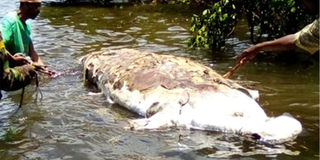Carcass of rare dugong found in Lamu

The carcass of a dugong that was found at Pezali area in Shanga-Rubu, Pate Island. PHOTO | KALUME KAZUNGU | NATION MEDIA GROUP
What you need to know:
- The endangered mammal species had not been sighted in Kenya’s coastal waters for years.
A carcass of the endangered Dugong, a marine mammal that eats seagrass, has been found by conservancy rangers at Pezali area in Shanga-Rubu on Pate Island in Lamu County.
Dugongs, also known as sea cows or nguva in Kiswahili, are large grey marine mammals which are related to elephants.
The rare species of marine mammals give birth to young ones and breastfeed their calves.
They have a whale-like flat tail and flippers that move up and down.
Confirming the spotting on Sunday, Pate Marine Community Conservancy (PMCC) Manager Nadhir Hashim said the rare mammal’s carcass was found by one Athman Shee Kupi, a corporal working at the conservancy.
The carcass estimated to be two to three days old was found lying in a mangrove forest.
The spotting of the Dugong sparked both sadness and excitement among fishermen and locals who showed up in the area to see the rare animal.
According to Mr Hashim, the endangered mammal species had not been sighted in Kenya’s coastal waters for years.
He said the cause of death of the Dugong is yet to be established though he suspects it might have been trapped in mangroves or consumed toxic plastic since the stomach did not appear normal.
“The carcass of the Dugong weighs about 200 kilogrammes and is approximately 6.5 feet tall. We’re yet to establish the real cause of its death but I suspect it might have eaten toxic plastic or trapped in mangroves before it died,” said Mr Hashim.
The PMCC’s Manager insisted on the need for concerted effort from all to ensure endangered species of animals, including dugongs, are well protected along the Kenyan Coast and the world at large.
“It’s sad that the dugong has been spotted while already dead. I however thank all our supporters and partners, including the Kenya Wildlife Services (KWS), Kenya Fisheries Service, County Government of Lamu and Northern Rangeland Trust (NRT) for supporting our vision as an organization which is to improve the livelihoods of our community through the conservation and sustainable use of natural resources. Let’s all join hands as the sea belongs to all of us and knows no boundaries,” said Mr Hashim.
Mr Kupi, who was the first person to spot the carcass, said it was disappointing for him to find the animal dead.
“I would be a very happy person if I’ve found the animal alive rather than dead. In fact I shed my tears shortly after seeing the dead dugong. I am a conservationist and I’ve really been at the forefront in protecting these endangered species of animals,” he said.
In 2000, a young dugong was caught in gillnets by fishermen in Lamu but was later released into the ocean.
In 2017, a mature adult dugong was found dead in a gillnet in Msambweni, Kwale County.
It is estimated that the remaining population of Dugongs in Kenya is less than 10, but an aerial census survey led by the Kenya Wildlife Service in 2017 recorded zero sighting of the marine mammal whose lifespan is up to 70 years and above.





